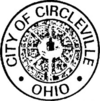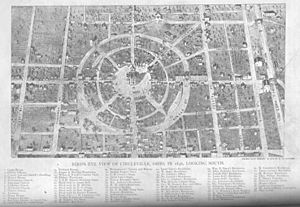Circleville, Ohio facts for kids
Quick facts for kids
Circleville, Ohio
|
||
|---|---|---|
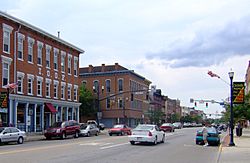
Circleville's Main Street
|
||
|
||
| Nickname(s):
Roundtown
|
||
| Motto(s):
"Home of the Pumpkin Show"
|
||
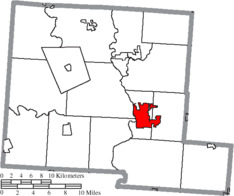
Location in Pickaway County
|
||
| Country | United States | |
| State | Ohio | |
| County | Pickaway | |
| Area | ||
| • Total | 7.34 sq mi (19.00 km2) | |
| • Land | 7.22 sq mi (18.69 km2) | |
| • Water | 0.12 sq mi (0.31 km2) | |
| Elevation | 689 ft (210 m) | |
| Population
(2020)
|
||
| • Total | 13,927 | |
| • Estimate
(2023)
|
14,452 | |
| • Density | 1,930.02/sq mi (745.20/km2) | |
| Time zone | UTC-5 (Eastern (EST)) | |
| • Summer (DST) | UTC-4 (EDT) | |
| ZIP code |
43113
|
|
| Area code(s) | 740, 220 | |
| FIPS code | 39-15070 | |
| GNIS feature ID | 2393527 | |
Circleville is a city in Ohio, United States. It is the main city of Pickaway County. The city is located along the Scioto River. It is about 25 miles (40 km) south of Columbus. In 2020, about 13,927 people lived there.
Circleville got its name from its unique original design. In 1810, the city was built inside a large circular earthwork. This earthwork was made by the ancient Hopewell tradition people. It was about 1,100 feet (335 meters) across. The county courthouse was built right in the middle of this circle.
Later, in the 1830s, people wanted to change the city's shape. They asked the state to allow them to make it a normal grid pattern. By the mid-1850s, the city was changed. All signs of the old circular earthwork were removed. However, many other similar ancient earthworks still exist in the Ohio Valley.
Contents
History of Circleville
In the mid-1700s, the Lenape (also known as Delaware Indians) moved west. English settlers were moving into Pennsylvania, pushing them out. The Lenape were allowed by the Wyandot to settle in the Ohio area. One of their villages was Maguck, built by 1750. It was on the banks of the Scioto River. Modern Circleville was built just north of where Maguck used to be.
A famous explorer named Christopher Gist was the first European to visit this area. He arrived at Maguck on January 20, 1751. He wrote that he stayed in the village for four days.
European-American settlers founded Circleville in 1810. They were moving west after the American Revolutionary War. The town's name came from the large circular earthwork. This earthwork was built by the ancient Hopewell culture. The town was built right on top of these old remains. The first town plan used the circular shape of the earthwork. It had streets in an 1,100-foot circle. This circle was connected to a 900-foot square. These earthworks were very old, built around 500 CE. The town's first courthouse was octagon-shaped. It was placed in the center of the circular town.
Caleb Atwater, a local historian, studied these Hopewell circles. He was one of the first archaeologists. He drew pictures of the earthworks in his 1820 report. This report was about ancient sites in Ohio.
However, people in Circleville were not happy with the circular layout. In 1837, the state of Ohio allowed a company to change the town. They wanted to make it a normal square grid. This change was finished in stages by 1856. Today, there are no signs left of the original earthworks. A few very old buildings still have curved walls. These walls were built to fit the town's first circular shape.
Circleville Tornado of 1999
On October 13, 1999, a strong tornado hit Circleville. It was an F-3 tornado. It started on the north side of town. It caused a lot of damage to buildings. A barber shop and a masonry building were badly hit. A furniture store also had a large hole in its roof. Items from inside the store were sucked out.
The tornado then moved into a neighborhood called Northwood Park. Several homes were destroyed there. Trees and cars were also heavily damaged. The tornado lifted as it crossed Edgewood Drive. But it still snapped the tops of some nearby trees.
Geography of Circleville
Circleville is located at 39°36′N 82°57′W / 39.600°N 82.950°W.
The city covers about 6.76 square miles (17.51 square kilometers). Most of this area is land. A small part, about 0.12 square miles (0.31 square kilometers), is water.
Calamus Swamp is a nature reserve near Circleville. It is 19 acres large. It is located about 1.5 miles (2.4 km) from the town.
Circleville Population
| Historical population | |||
|---|---|---|---|
| Census | Pop. | %± | |
| 1820 | 908 | — | |
| 1830 | 1,136 | 25.1% | |
| 1840 | 2,329 | 105.0% | |
| 1850 | 3,411 | 46.5% | |
| 1860 | 4,383 | 28.5% | |
| 1870 | 5,407 | 23.4% | |
| 1880 | 6,046 | 11.8% | |
| 1890 | 6,556 | 8.4% | |
| 1900 | 6,991 | 6.6% | |
| 1910 | 6,744 | −3.5% | |
| 1920 | 7,049 | 4.5% | |
| 1930 | 7,369 | 4.5% | |
| 1940 | 7,989 | 8.4% | |
| 1950 | 8,723 | 9.2% | |
| 1960 | 11,059 | 26.8% | |
| 1970 | 11,687 | 5.7% | |
| 1980 | 11,682 | 0.0% | |
| 1990 | 11,666 | −0.1% | |
| 2000 | 13,485 | 15.6% | |
| 2010 | 13,314 | −1.3% | |
| 2020 | 13,927 | 4.6% | |
| 2023 (est.) | 14,452 | 8.5% | |
| Sources: | |||
In 2010, there were 13,314 people living in Circleville. There were 5,402 households. About 30.3% of these households had children under 18. The average household had 2.36 people.
The city's population was mostly White (95.4%). About 1.9% were African American. Other groups made up smaller parts of the population. About 1.1% of the people were Hispanic or Latino.
The average age in the city was 39.3 years old. About 23.3% of residents were under 18. About 17.7% were 65 or older.
Economy and Jobs
Many people in Circleville work in manufacturing. This means they work in factories that make things. In 2010, about 13.4% of people in the county worked in manufacturing.
Circleville is home to a large DuPont chemical plant. It opened in the 1950s. This plant makes special plastic films called Mylar and Tedlar. Tedlar is used a lot in making solar panels. PACCAR, a company that makes trucks, also has a big factory here. It has been in Circleville for over 35 years.
Sofidel Group, a big company that makes tissue paper, built a huge plant in Circleville. It cost $400 million. This plant is 1.4 million square feet. When it is fully running, it will employ about 700 people. The first paper was made there in June 2018.
The PPG Industries plant in Circleville makes special resins. These are used mainly for cars. Global Transmission Parts, a company that sells car parts, has its main office and warehouse here.
Other major employers in Circleville include OhioHealth (a healthcare company). The local school districts also employ many people. These are Circleville City, Teays Valley Local, and Logan Elm Local School districts. Circle Plastics/TriMold LLC, the State of Ohio, and Wal-Mart Stores are also big employers.
Fun Things to Do
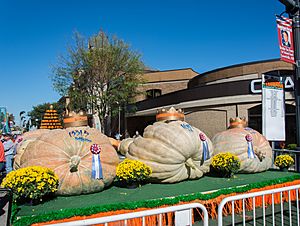
Circleville is famous for its Circleville Pumpkin Show. This big festival happens every October. People come from all over to see giant pumpkins and enjoy the fun.
The Clarke-May Museum is also in Circleville. It is run by the Pickaway County Historical Society. You can learn about the area's history there.
Education in Circleville
The Circleville City School District has one elementary school and one middle school. It also has Circleville High School.
Ohio Christian University is a college in Circleville. It has been open since 1948. It is connected to the Churches of Christ in Christian Union.
Circleville also has a public library. It is a branch of the Pickaway County Library.
Famous People from Circleville
- Caleb Atwater – He was called the "father of Ohio's public school system." He was also Ohio's first historian. He studied ancient Native American mounds and earthworks.
- Conchata Ferrell – An actress known for playing Berta in the TV show Two and a Half Men.
- Ted Lewis – A famous musician and bandleader from the 1920s. There is a museum and a park named after him in the city.
- Dwight Radcliff – He was the longest-serving sheriff in US history.
- Kohl Sudduth – An actor known for the Jesse Stone TV movies.
Images for kids
See also
 In Spanish: Circleville (Ohio) para niños
In Spanish: Circleville (Ohio) para niños


